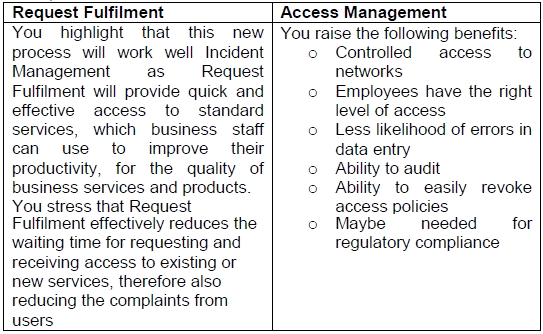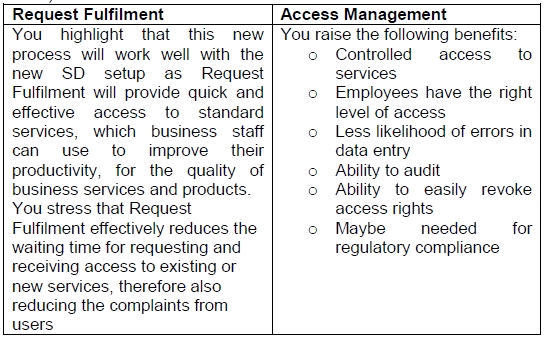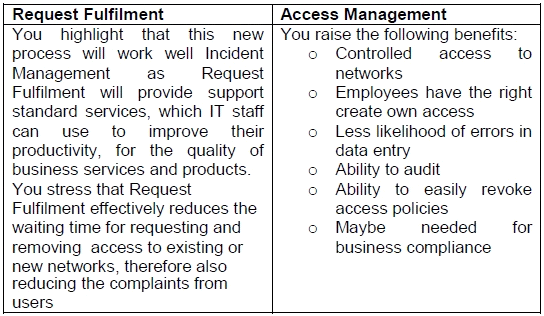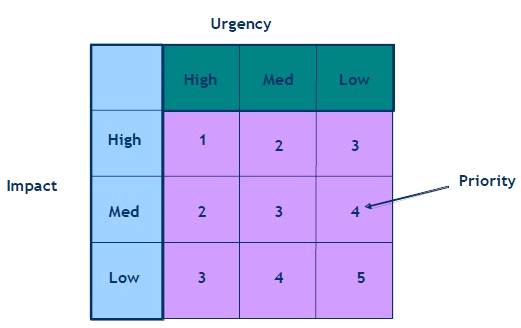PeopleCert ITIL Service Capability Operational Support and Analysis ITILSC-OSA Exam Practice Test
Scenario
Vision Media is an international media organization, operating various lines of business including:
Film Production
Television (production and delivery of their own channel in the United States VisionOne)
Print media (including newspapers in 15 countries)
Online Advertising
The organization has recently been restructured, and now is comprised of the following companies and departments:
Vision Films (production of movies and television shows)
VisionOne (television channel)
VisionNews (coordinates all of the sub-companies involved in the delivery of printed newspapers, as well as being the centralized source of news information for all company owned media outlets)
VisionNet (managing the online and internet businesses)
Legal Services
Finance and Administration
Human Resources
Information Technology
The organization is also actively pursuing growth in the online market, and is currently holding discussions with the leading online news provider about the possible acquisition of their company. This would increase the overall size of Vision Media by around 15%.
The Information Technology department acts as a Shared Service Unit, providing IT Services to all of sub-companies and departments, which complement some of the Internal Service Providers that also exist. The director of Information Technology has realized the need to improve the quality of services offered by implementing ITIL, and has decided to do so using a phased approach. Some of the Service Design and Service Transition processes have already been implemented, and they are now planning the implementation of Service Operation.
While the IT director does have tentative support from the other directors and CEO, budgets for implementing the Service Operation processes have not been finalized, and still require a business case to be formally submitted.
Refer to the exhibit.
The IT director is required to submit a business case to the board of directors of Vision Media for the implementation of Service Operation. Which of the following responses is the BEST summary of the benefits of implementing Service Operation (processes and functions), to be included in the business case?
Answer : B
Scenario
Brewster's is a toy factory that has been in business for 30 years. The company started with a small family run shop and has grown consistently over the years. They are now supplying toy stores nationwide and are considered to be the primary supplier of children's collectable novelty erasers.
Brewster's IT department is relatively small (currently 15 staff) but efficient. They have recently employed an IT Manager in an attempt to improve the management of the infrastructure, as well as more effective use of resources and identification of areas for improvement.
The Brewster's management teams do not have a lot of IT knowledge. The newly appointed IT Manager is very ITIL focused and wants to implement as many ITSM processes as is appropriate there are currently no formal processes in place. On starting with the company the IT Manager completed an internal assessment of the IT infrastructure -- including staff skills analysis, and collated the results from customer satisfaction surveys completed over the last 5 years.
The main areas of concern are as follows:
Responses from customer satisfaction survey:
Overall a consistent satisfaction level. However, responses completed during the past 12 months show an increase in customers who were unsatisfied with call waiting times when contacting the service desk for help with online orders and requests for information.
Customers added the following additional comments:
''Never get to speak to the same person twice when dealing with an Incident number, had to call several times to receive follow up on progress''
''Some of the Service Desk staff seem under qualified to deal with my questions about new applications/incidents/service requests''
Results from Staff Skills Analysis:
Staff, in general, have a good knowledge of IT systems and a basic understanding of the business processes and objectives. However, staff are not well informed of upcoming releases of new or changed services and not given adequate information to relay to the customers.
Staff added the following additional comments:
''Communication between Service Operation departments has become inefficient - there are meetings for the sake of meetings, but the important information we need to know to do our day to day jobs is lacking''
''I still don't know what half of the people do, that work in the IT department!''
Results from General IT Infrastructure assessment:
Lack of event monitoring and planning
Lack of input from Operational Support departments into Service Design
Lack of skill and information sharing across the Operational Support teams with regards to Incident, Problem, Workarounds and Known Error data.
Little to no proactive activities being carried out.
Refer to Scenario
Which of the following options would be the most effective option to address the issues identified from the Staff Skills Analysis?
Answer : A
Scenario
You are the CIO of a large stock broking firm, based in Hong Kong. Recently this company has acquired two other major firms in London and New York. Total Company staff now exceeds 800 people. Each Firm currently has their own Service Desk.
Hong Kong has 10 SD staff to 400 employees, with 6 2nd level support staff
London has 3 SD staff to 140 employees with 3 2nd level support staff
New York has 5 SD staff to 250 employees with 5 2nd level support staff
With this new merger comes new support issues. Complaints are coming in to say that there si an imbalance with ratio of IT support staff to users, Service Desks in London and New York are having trouble knowing and supporting new systems which has resulted in users calling Hong Kong Service Desk. This has resulted in higher resolution times and an inability to get through to the service desk The Business is not happy with the current situation.
Refer to the scenario.
A)

B)

C)

D)

Answer : A
Scenario
You are the CIO of a large stock broking firm, based in Hong Kong. Recently this company has acquired two other major firms in London and New York. Total Company staff now exceeds 800 people. Each Firm currently has their own Service Desk.
Hong Kong has 10 SD staff to 400 employees, with 6 2nd level support staff
London has 3 SD staff to 140 employees with 3 2nd level support staff
New York has 5 SD staff to 250 employees with 5 2nd level support staff
With this new merger comes new support issues. Complaints are coming in to say that there si an imbalance with ratio of IT support staff to users, Service Desks in London and New York are having trouble knowing and supporting new systems which has resulted in users calling Hong Kong Service Desk. This has resulted in higher resolution times and an inability to get through to the service desk The Business is not happy with the current situation.
Refer to the scenario.
As CIO, you decide to reorganize the Service Desk structure as a means to address the levels of service. You decide to use a follow the sun Service Desk. Which of the following descriptions to you present to the Business as your solution?
Answer : C
The success of Service Operation phase is based on some important Critical Success Factors. From the options below, which would be the most important for Service Operation?
Answer : D
Operations Control refers to?
Answer : B
Scenario
Vision Media is an international media organization, operating various lines of business including:
Film Production
Television (production and delivery of their own channel in the United States VisionOne)
Print media (including newspapers in 15 countries)
Online Advertising
The organization has recently been restructured, and now is comprised of the following companies and departments:
Vision Films (production of movies and television shows)
VisionOne (television channel)
VisionNews (coordinates all of the sub-companies involved in the delivery of printed newspapers, as well as being the centralized source of news information for all company owned media outlets)
VisionNet (managing the online and internet businesses)
Legal Services
Finance and Administration
Human Resources
Information Technology
The organization is also actively pursuing growth in the online market, and is currently holding discussions with the leading online news provider about the possible acquisition of their company. This would increase the overall size of Vision Media by around 15%.
The Information Technology department acts as a Shared Service Unit, providing IT Services to all of sub-companies and departments, which complement some of the Internal Service Providers that also exist. The director of Information Technology has realized the need to improve the quality of services offered by implementing ITIL, and has decided to do so using a phased approach. Some of the Service Design and Service Transition processes have already been implemented, and they are now planning the implementation of Service Operation.
While the IT director does have tentative support from the other directors and CEO, budgets for implementing the Service Operation processes have not been finalized, and still require a business case to be formally submitted.
Refer to the exhibit.
Sally Robbins, who had previously managed the IT department's Service Desk, has now been assigned the role of Incident Manager. To assist in the implementation of the process, Sally has conducted a number of meetings with IT staff, customers, external suppliers and other relevant stakeholders to identify their requirements. Based on these discussions, Sally has created following impact definitions, which will be used in conjunction to the given urgency to determine the appropriate timescales and effort applied for response and resolution to recorded incidents.

Impact Definition:
Low Impact
Affects a single user, preventing them from performing normal work functions
A single, non-critical device or peripheral is unavailable
Medium Impact
Multiple users are affected, preventing them from performing normal work functions
A regular business function is unavailable to part of a or organizational unit department
High Impact
A vital business function is unavailable to an entire department or company owned organization
Major Incident
A vital business function is unavailable to all Vision
Media departments and company owned organizations
Example Incidents:
Answer : B